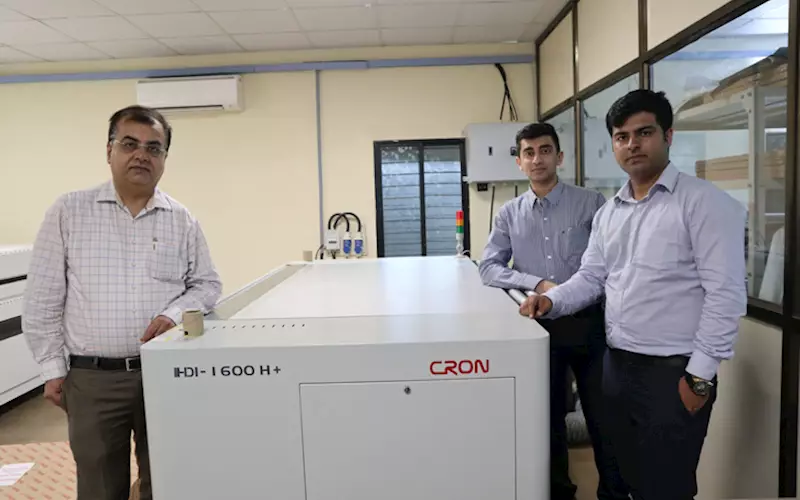Vapi's corrugation specialist ventures into platemaking business with Cron flexo and offset platesetters
Vapi-based Vasundhara Packaging Industry has diversified into platemaking business with the installation of a Cron HDI-1600H+ series flexo platesetter, G&J Processing Equipment, and Founder’s Eagle RIP as well as Cron 4664G+ CTCP for offset platemaking.
04 Jul 2019 | By Abhishek Muralidharan
Jatin Udeshi, managing director at Vasundhara informed the PrintWeek India team, during its visit to the platemaking unit, that the new business vertical will be operated under the banner of Aadya Graphics, and will be helmed by his 23-year old son Harsh.
Udeshi has also roped in pre-press specialist Shrirang Sahasrabudhe as the technical director to help manage the firm.
Vasundhara was established in 1999 and has three plants operating in Vapi converting around 400+ tonnes of corrugated board per month. “We were looking to diversify into a new business, did our research and found potential in the platemaking segment,” said Udeshi. “And in Sahasrabudhe we found the right person to handle the project.”
In February 2019, Aadya installed the Cron platemaking equipment, processing equipment and software required for setting up the unit. “We opted for the Cron machines because of two factors, performance and price. We took trials on the machine and we were satisfied with the quality.”
The Cron HDI-1600H+ is equipped with a motion controlling system on a linear magnetic rail and a can deliver multiple resolutions of up to 9,600dpi. It is capable of producing 4.6 sqm plates per hour. Sahasrabudhe said, “It’s a wider format kit, 60x47inch, which allows us to produce more plates. And though we can produce at 9,600dpi, is not an essential requirement as of today. However, we are in a position to do produce it, if required.”
The other feature of the Cron HDI-1600H+ is the individual laser diodes, which lowers maintenance cost. “There’s no need of replacing the entire panel of diodes, just the one that’s not functional. It reduces replacement cost. Besides, the lasers have internal amplification. Even if you are not able to replace the non-functional diode, the rest of the functional diodes manage imaging. Cron’s Laboo software monitors the uniformity of power,” said Sahasrabudhe.
Akshat Pardiwala, COO at Nippon Color, the Indian representative for Cron, which supplied the platesetters, explained the functions of the laser diodes which help lower the maintenance cost. “The number of diodes depends on the model of the platesetter one opts for. The HDI-1600H+ installed at Aadya has 48 diodes. If one diode is non-operational, the machine will still operate on 47 diodes (depending on the position of the failed diode). So if 1 diode is non-operational, the machine will still operate on 47 diodes (depending on the position of the failed diode). Diode positions are from zero to 47. If diode zero is non-operational, the machine will run from diode one to 47. If diode 10 is non-operational, the machine can be set to run on diodes 11-47, and shut zero to 10. The speed will be slightly affected but production is never stopped.”
Pardiwala added, “In the meantime, our engineer can visit the customer and replace the diode or re-position the non-operational diode to position zero for the least loss of speed.”
On the business front, Aadya has been producing 300 sqm per month but is hoping to get to 10,000 sqm per month. “In Daman, Vapi and Silvassa, there are over 500 corrugation units. While some use plates supplied by us, many still use rubber plates produced in the conventional method. We hope to convert these, as the cost difference is about 20%,” said Udeshi. “Moreover, many corrugators are now opting for multi-colour flexo presses, who we hope to serve.”
Aadya has also set a target of 5,000 plates per month for the offset platemaking unit. “The big players in the area are equipped with CTP unit in-house. Those who outsource their plate requirement from outside of Vapi are the once we will cater to,” concluded Udeshi.














 See All
See All